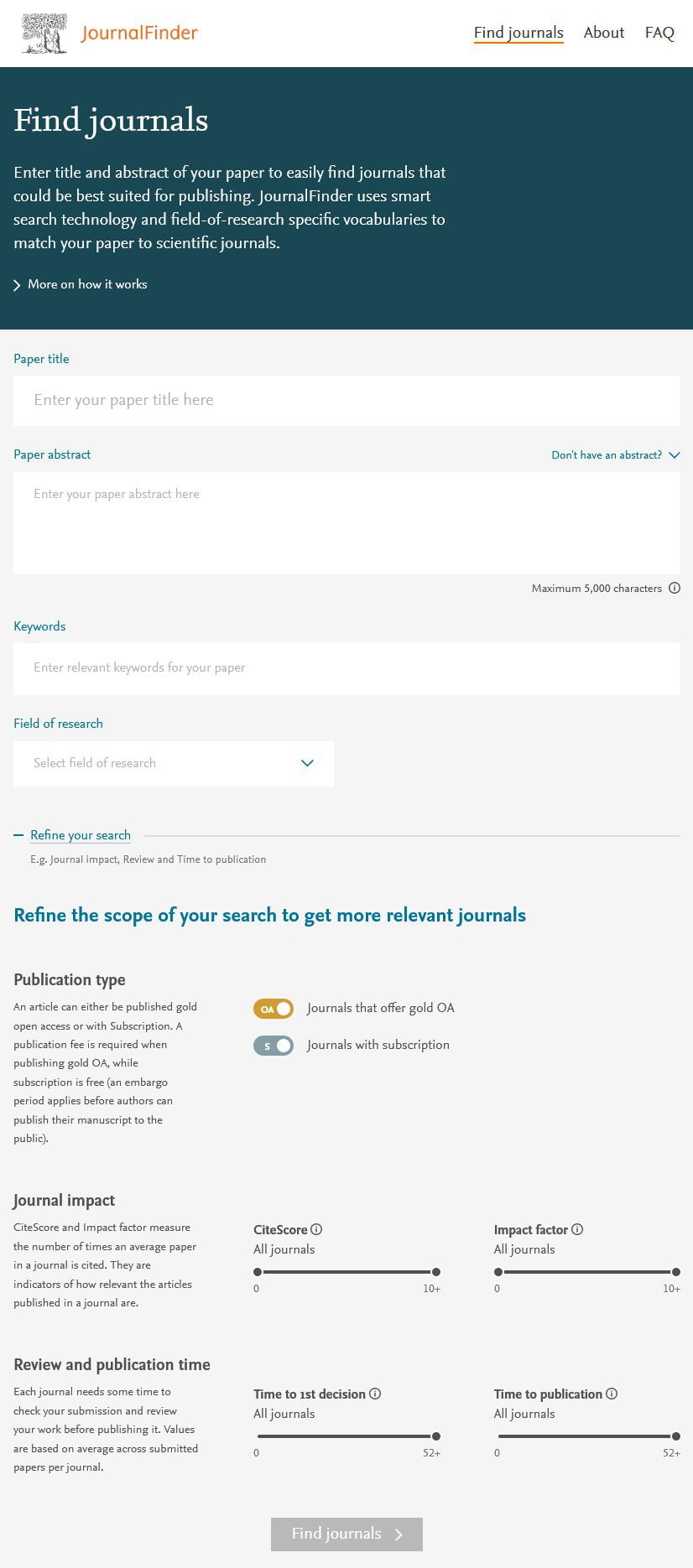Last Updated on April 1, 2023
Submitting research articles to a scientific journal is one way to publish research results. It aims to disseminate knowledge and the latest breakthrough results from conducting research.
However, the aim and scope of the journals are getting more specific. This causes many authors to submit their articles to unsuitable journals. It is a common mistake that causes journal editors to immediately reject the articles.[1]
Therefore, it is very important to find the most potential target journals to publish our articles. Because this will increase the likelihood of our article being accepted for publication in that journal. This article provides tips on how to find and determine potential journals to publish our articles.
Set the criteria of our target journal
Aims and scope
Most journals have information about the aims and scope on their website, usually on about page. Based on that, credible journals may reject submitted articles that do not fall within the aims and scope of the journal. Therefore, we need to understand the aims and scope of each target journal.
Journals with aims and scope that may not be suitable for our article or research should be removed from consideration.
Open access or by subscription
For each article we submit, Most international journals offer choice of publication models. The first option is open access. It means that everyone can read our published articles for free. It aims to reach as many readers as possible. Moreover, it makes it possible to get more cites from readers. However, commonly, when choosing open access, we have to pay costly Article Processing Charges (APC). The average APC for reputable international journals ranges from USD 2,000 to USD 3,000+ [2].
The second option is to access by subscription. This means that readers must pay a subscription fee to the journal or buy each article they need to read. In this case, the author of the article is not charged from the submission until the article is published. However, authors are not allowed to provide their articles to the public within a certain period of time set by the journal (embargo period).
Therefore, we need to choose one of these two options based on our needs and financial capabilities.
Journal reputations
We can check the reputation of a journal from the journal’s metrics, especially the impact factor (IF). Besides IF, there are several other metrics such as CiteScore, Eigenfactor, Google Scholar Metrics, SCImago Journal & Country Rank (SJR), and Source Normalized Impact per Paper (SNIP)[3].
Generally, the higher the metric of a journal, the higher the ranking of the journal. The higher the rank of a journal, generally the lower its acceptance rate. In other words, the more stringent the selection process for articles in the journal will be
Therefore, once we have selected some of the target journals, we can sort them by these metrics. This order will also be the order of our article submissions. Basically, the first order is the target journal that we will submit first.
Review and publication time
The articles processing from submission, review, to publication, takes a long time. Generally, it ranges from a few months to more than a year. Even so, this has no effect on the quality and credibility of a journal.
However, sometimes we also have our own time limit to publish the results of our research. Therefore, we need to look for journals with a rather short article processing time.
Make a list of target journals
Based on the journal criteria that we have set, we can make a list of potential target journals. We may have one target journal that we think is most relevant. However, it would be nice if we also had a second or third target journal [1]. Because if our article is rejected in the first target journal, we can send it to the next target journal quickly. Therefore, make sure to have at least three suitable target journals, as in the example in Table 1.

If you don’t have target journals relevant to your article, some of the following tips may be a great help in your search for target journals. That way we hope you can easily make your list of target journals for your publication.
Tips to find a potential target journal
Referring to your references
When we finish writing a research article, maybe some of us don’t have any potential target journals to publish the article. Therefore, the easiest way to find potential journals is to start with references that we have cited [1]. At least some of those reference sources discuss similar things.

Basically, just revisit our references. Then, make a list of the target journals of based on the list of references that we cite in the article, as in Figure 1. Hereinafter, we can sort the list of target journals of our destination based on the criteria of the journal we set.
Using a journal search site
To add to the list of potential target journals, we can also search for journals through journal search sites. In this case, we can use journal search sites provided by several well-known publishers, such as:
- Elsevier – Journal Finder. You may want to go to Scopus or SCImago to look for any potential journals. However, the Elsevier B.V. has another system called Journal Finder[4]. This system has a great tool to filter journals according to our criteria. Basically, we only need to write the title and abstract of our article, along with our keywords and field of research. In addition, we can also filter journals by publication type (open access or with subscription), by journal citation metrics, and also by review and publication time.
- Springer – Journal Suggester. The Springer Nature also has a system similar to Elsevier’s Journal Finder [1]. This system has a complete filter as Elsevier’s does. However, in Springer’s Journal Suggester, we can search for journals by filtering by acceptance rate.
- Wiley – Journal Finder. The John Wiley & Sons, Inc. has a simple system called Journal Finder. We simply enter the title and abstract of our article, and the system will search for suitable journals. However, there are no filter controls to get to a specific search. Although Journal Finder can be used, this system is still in the beta development stage.
- Taylor & Francis – Journal Suggester. The Taylor & Francis Group has a Journal Suggester system which is simpler than the Wiley system[5]. In fact, we only need to enter the abstract of our article to get a list of journal recommendations. However, even though we can use Suggester Journal, this system is still in the beta development stage.
- Clarivate – Manuscript Matcher. Some of you may already be familiar with the Web of Science (WoS). Clarivate is the company behind it. The WoS platform has a Manuscript Matcher feature to search for journals according to our needs. We simply enter the title and abstract of our article, and the system will search for the appropriate journal. However, to use this feature, we must first log in using a WoS account. You can also sign up for a WoS account if you don’t already have one.

Avoid predatory journals
In recent years, the number of predatory journals has continued to increase[6]. Basically, predatory journals or publishers are those who claim to be legitimate scientific journals but carry out illegal publishing practices, or even fraud[7]. In other words, they receive articles for publication, along with journal processing fees. But generally without carrying out the correct quality inspection standards such as peer review, plagiarism checks, or ethical approval[8].
Publishing articles in predatory journals or publishers is very risky. Generally, articles published in predatory journals or publishers may not be acknowledged and used by others [7]. It may even be at risk of hindering our careers and research.
Before submitting an article to a journal, we need to take the time to check whether the journal is trustworthy. Some sites that we can use to check the credibility of a journal are Think. Check. Submit. and Beall’s list.
References
- [1]SpringerOpen, “Find the right journal,” BioMed Central Ltd – Springer Nature. https://www.springeropen.com/get-published/find-the-right-journal (accessed Feb. 25, 2021).
- [2]B.-C. Björk and D. Solomon, “Open access versus subscription journals: a comparison of scientific impact,” BMC Med, Jul. 2012, doi: 10.1186/1741-7015-10-73.
- [3]Library, “Evaluating Journals Using Journal Metrics: Overview,” Walden University, May 19, 2020. https://academicguides.waldenu.edu/library/journalmetrics (accessed Jun. 25, 2021).
- [4]H. Zijlstra, “‘What’s the best journal for my paper?’ New tool can help,” Elsevier Connect, Aug. 06, 2019. https://www.elsevier.com/connect/whats-the-best-journal-for-my-paper-new-tool-can-help (accessed Jun. 26, 2021).
- [5]Author Services, “Choosing a journal: Ask the right questions, and get the right result,” Taylor & Francis Online: Author Services. https://authorservices.taylorandfrancis.com/publishing-your-research/choosing-a-journal/ (accessed Jun. 26, 2021).
- [6]Springer, “OA vs. subscription journals,” Springer Nature. https://www.springer.com/gp/authors-editors/authorandreviewertutorials/open-access/oa-vs-subscription-journals/10286532 (accessed Jun. 26, 2021).
- [7]S. A. Elmore and E. H. Weston, “Predatory Journals: What They Are and How to Avoid Them,” Toxicol Pathol, pp. 607–610, Apr. 2020, doi: 10.1177/0192623320920209.
- [8]A. Grudniewicz et al., “Predatory journals: no definition, no defence,” Nature, pp. 210–212, Dec. 2019, doi: 10.1038/d41586-019-03759-y.
Cover image by freepik



